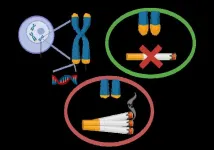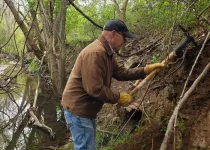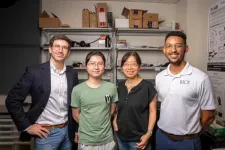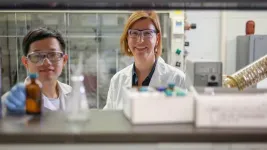(Press-News.org) Milan, Italy: For the first time, researchers have shown it is possible to repair damaged lung tissue in patients with chronic obstructive pulmonary disease (COPD) using the patients’ own lung cells.
The European Respiratory Society International Congress in Milan, Italy [1], heard that 17 patients who took part in a phase I clinical trial were able to breath better, walk further and had better quality of life after receiving the experimental treatment.
COPD kills approximately three million people worldwide every year. It is a severe respiratory disease that involves progressive damage to lung tissue. The affected tissue cannot be repaired with current treatments, only alleviated with medicines that widen the airways to improve airflow, known as bronchodilators.
To find new treatments for COPD, researchers have been investigating stem cells, which are capable of differentiating into any cell in the body, and progenitor cells, which are descendants of stem cells and can only differentiate into the cells that belong to the same tissue or organ and are normally used by the body to repair and replace damaged tissue. However, to date, the results have been conflicting, particularly for stem cells.
Professor Wei Zuo, of the School of Medicine, Tongji University, Shanghai, China, and chief scientist at Regend Therapeutics Ltd in China, and his colleagues have been investigating whether a type of cell called P63+ lung progenitor cells might be able to regenerate lung tissue damaged by COPD.
“Stem cell and progenitor cell-based regenerative medicine may be the biggest, if not the only, hope to cure COPD,” he told the congress. “P63+ progenitor cells are known for their ability to regenerate the tissues of the airways, and previously we and other scientists have shown in animal experiments that they can repair the damaged epithelial tissue in the alveoli – the tiny air sacs in the lungs that play a crucial role in the exchange of gases between air breathed in and the blood supply to the lungs.”
In this first phase I clinical trial, the researchers set out to investigate the efficacy and safety of taking P63+ progenitor cells from the lungs of 20 COPD patients, using them to grow millions more in the laboratory, before transplanting them back into the patients’ lungs.
“In our trial, 35% of the patients had severe COPD and 53% had extremely severe COPD. Usually, many patients with such severe COPD will die quite quickly if their disease progresses. We used a tiny catheter that contains a brush to collect the progenitor cells from the patients’ own airways. We cloned the cells to create up to a thousand million more, and then we transplanted them back into the patients’ lungs via bronchoscopy in order to repair the damaged lung tissue.”
Of the 20 patients, 17 were treated in this way and three were not and constituted the control group. They were assessed within 24 weeks of treatment to evaluate how well they tolerated the treatment and its effectiveness.
The cell treatment was well tolerated by all patients. After 12 weeks, the median (average) diffusing capacity of the lungs (DLCO), which tests how well air is exchanged between the lungs and the bloodstream, increased from 30% before treatment to 39.7%, and then increased further to 40.3% at 24 weeks in the treated patients. The median distance covered in a six-minute walk distance test (6MWD) increased from 410 metres before treatment to 447 metres at 24 weeks. The median score in a quality-of-life test (St George’s Respiratory Questionnaire or SGRQ) reduced by seven points, indicating an improvement. In two patients with mild emphysema, a type of lung damage that is normally permanent and progressive, the treatment repaired the lung damage.
Prof. Zuo said: “We found that P63+ progenitor cell transplantation, not only improved the lung function of patients with COPD, but also relieved their symptoms, such as shortness of breath, loss of exercise ability and persistent coughing. This means that the patients could live a better life, and usually with longer life expectancy.
“If emphysema progresses, it increases the risk of death. In this trial, we found that P63+ progenitor cell transplantation could repair mild emphysema, making the lung damage disappear. However, we cannot repair severe emphysema yet.”
The researchers are planning a phase II trial of the treatment, which will evaluate its efficacy in a larger group of patients. The trial has been approved by China’s National Medical Products Administration (NMPA), the Chinese equivalent of the US Food and Drugs Administration (FDA). This means that the treatment is not generally available to COPD patients and their doctors yet.
“However, with more doctors and patients participating in our clinical trial, we may develop the treatment more quickly so that it can benefit patients sooner,” said Prof. Zuo. “A similar therapeutic strategy is also being tested in patients with lethal lung fibrotic diseases, including idiopathic pulmonary fibrosis. We are going to test the treatment’s efficacy in larger groups of people with more lung diseases. We hope to develop the treatment for clinical use within about two to three years.”
Professor Omar Usmani, of Imperial College London (UK), is Head of the European Respiratory Society group on airways disease, asthma, COPD and chronic cough. He commented: “The results from this phase I clinical trial are encouraging. COPD is in desperate need of new and more effective treatments, so if these results can be confirmed in subsequent clinical trials it will be very exciting. It is also very encouraging that two patients with emphysema responded so well. A limitation of this study is that the uptake of the progenitor cells when they were transplanted back into the patients is uncontrolled. So we do not know whether the lungs of some patients responded better to the transplantation than other. We hope this information may become apparent in future studies.”
(ends)
[1] Abstract no: 2 OA. “Autologous transplantation of P63+ lung progenitor cells for chronic obstructive pulmonary disease therapy”, by Prof. Wei Zuo et al. Presented in session “Innovative Approaches to Managing Asthma and COPD: A Translational Perspective” from 11.00-12.15 hrs CEST on Tuesday 12 September 2023. https://k4.ersnet.org/prod/v2/Front/Program/Session?e=379&session=16493
END
Transplanting patients’ own lung cells offers hope of ‘cure’ for COPD
2023-09-12
ELSE PRESS RELEASES FROM THIS DATE:
Genetic evidence shows that smoking can cause us to age faster
2023-09-12
Milan, Italy: A study of nearly 500,000 people has shown that smoking shortens the end fragments of chromosomes in the white blood cells of our immune systems. The length of these end fragments, called telomeres, is an indicator of how quickly we age and our cells’ ability to repair and regenerate.
In her presentation to the European Respiratory Society International Congress in Milan, Italy [1], Dr Siyu Dai, who is an assistant professor in the School of Clinical Medicine, Hangzhou Normal University, and also an honorary postdoctoral researcher in the department of paediatrics, The Chinese University of Hong Kong, said: “Our study shows that smoking status and ...
Alive without a pulse: Evolution of durable left ventricular assist devices
2023-09-11
https://www.scienceopen.com/hosted-document?doi=10.15212/CVIA.2023.0056
Announcing a new article publication for Cardiovascular Innovations and Applications journal. Durable left ventricular assist devices (LVADs) offer a viable option for patients with advanced heart failure and have been demonstrated to be superior to optimal medical therapy in terms of both mortality and quality of life, in selected patients. However, durable LVADs can be associated with severe morbidity. Because the rates of cardiac ...
Doctoral student’s "fear of positivity" research could assist with effective depression treatments
2023-09-11
STARKVILLE, Miss.—How can positive experiences seem like the opposite for some?
A doctoral student in Mississippi State University’s Clinical Psychology program believes this phenomenon is true, and his recent research is featured in an upcoming issue of The Journal of Behavioral Therapy and Experimental Psychiatry.
Michael R. Gallagher’s article “A network analytic investigation of avoidance, dampening, and devaluation of positivity” focuses on how behaviors related to processing positive experiences may play a role ...
Stem cell-derived components may treat underlying causes of PCOS
2023-09-11
Polycystic ovary syndrome (PCOS) is a pervasive endocrine disorder that affects millions of women globally, impacting their hormonal balance, fertility and overall well-being. It is notoriously difficult to treat, with widely varying symptoms and mysterious, complex underlying causes. Researchers at the University of Chicago recently unveiled a potential new PCOS treatment that may improve multiple PCOS symptoms by regulating body systems and reducing inflammation.
Recently published results demonstrate the promise ...
Urban parks built on former waste incineration sites could be lead hotspots
2023-09-11
DURHAM, N.C. – For much of the last century, many cities across the United States and Canada burned their trash and waste in municipal incinerators. Most of these facilities were closed by the early 1970s due to concerns about the pollution they added to the air, but a new Duke University study finds that their legacy of contamination could live on in urban soils.
“We found that city parks and playgrounds built on the site of a former waste incinerator can still have greatly elevated levels of lead in their surface soils many decades after the incinerator was closed,” ...
You can leave your gloves on: Rice-developed material burns viruses, safe for skin
2023-09-11
HOUSTON – (Sept. 11, 2023) A new material that packs deadly heat for viruses on its outer surface while staying cool on the reverse side could transform the way we make and use personal protective equipment (PPE), cutting down the pollution and carbon footprint associated with current materials and practices.
The composite, textile-based material developed by Rice University engineers uses Joule heating to decontaminate its surface of coronaviruses like SARS-CoV-2 in under 5 seconds, effectively killing at least 99.9% of viruses. Wearable items made from the material can handle hundreds of uses with the potential for a single pair of gloves to prevent nearly ...
Not too big: Machine learning tames huge data sets
2023-09-11
LOS ALAMOS, N.M., Sept. 11, 2023 — A machine-learning algorithm demonstrated the capability to process data that exceeds a computer’s available memory by identifying a massive data set’s key features and dividing them into manageable batches that don’t choke computer hardware. Developed at Los Alamos National Laboratory, the algorithm set a world record for factorizing huge data sets during a test run on Oak Ridge National Laboratory’s Summit, the world’s fifth-fastest supercomputer.
Equally efficient on laptops and supercomputers, ...
UArizona Cancer Center researchers discover iron-targeting approaches to halt proliferation of cancer cells
2023-09-11
Researchers at the University of Arizona Cancer Center discovered a new class of iron-targeting compounds that hamper the proliferation of cultured malignant cells in a laboratory setting. The results of the study were published in the Journal of the American Chemical Society.
“Cancer cells are what we call ‘addicted’ to iron, and so we are making compounds that are able to interfere with the availability of iron in cancer cells,” said Elisa Tomat, PhD, professor in the Department of Chemistry ...
Experimental physicist David Weld to investigate the role of feedback and measurement in quantum systems
2023-09-11
(Santa Barbara, Calif.) — Experimental physicist David Weld’s experimental research interest lies in a question that has been around for a long time, but which we’re only now approaching the ability to investigate.
“There’s a really old interest in the quantum act of measurement,” he said. “It’s something that’s at the foundations of quantum mechanics and has been puzzling people for more than a century.”
Called the “measurement problem” and famously illustrated by Erwin Schrödinger’s ...
ORNL teams receive funding through DOE BRaVE initiative to study biopreparedness
2023-09-11
The Department of Energy’s Office of Science has selected three Oak Ridge National Laboratory research teams to receive funding through DOE’s new Biopreparedness Research Virtual Environment, or BRaVE, initiative.
BRaVE, announced earlier this year, aims to build on biopreparedness research that delivered high-impact results in the fight against COVID-19. In the height of the pandemic, DOE national laboratory scientists combined fields such as biology, high-performance computing and manufacturing to bolster the national supply of personal protective equipment and improve virus testing and treatment.
“The advances made ...





